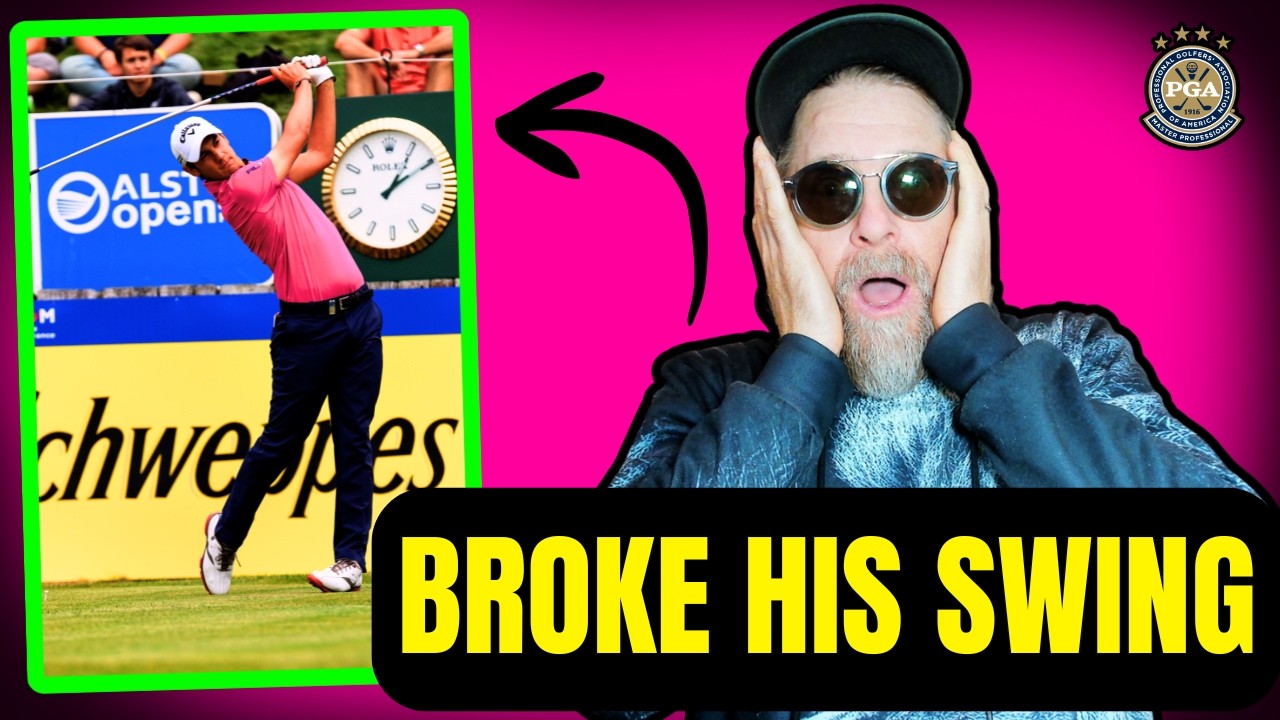Matteo Manassero was a phenom at 17… until he changed his golf swing chasing distance. In this video, I break down exactly how those changes affected his tilt, shaft pitch, timing, and natural matchups, and why the rebuild backfired. This isn’t a deep dive, just a clear cause and effect look at how a great motion can unravel when you chase the wrong things. Let’s take a closer look at what really happened.
🎥 Join us for Sunday Red Light Live – a FREE livestream reviewing subscriber swings.
📩 Want your swing reviewed? Send your videos to: https://form.jotform.com/251687122934158
Join this channel to help support the children in Cape Flats, South Africa:
https://www.youtube.com/channel/UCaDe37093HftJsFzrmLQUZA/join
For information on our development programs around Southern California in Los Angeles, San Diego and the Coachella Valley please visit:
Follow us on Instagram
https://www.instagram.com/lion_family_golf_academies/
Follow us on Facebook:
https://www.facebook.com/lionfamilygolf
#liongolfacademy #hitthebell #subscribe
Matteo Manasero might be the perfect example of what happens when a young phenom tries to rebuild a golf swing that doesn’t need rebuilding. This kid burst onto the scene, winning at 17, beating grown men with emotion that fit his body perfectly, and then he chased distance, changed the DNA of his swing, and everything started unraveling. Today, I’m going to show you exactly what changed, why it didn’t match his natural patterns, and how that swing rebuild turned a world-class ball striker into a guy fighting to keep his card. Cause and effect, that’s the whole story. And real quick, I created this channel to give you the other side of the instructional world. Not the quick fix promises, but the truth that actually speaks to your needs and not your wishes. Three decades of teaching amateurs have taught me one thing. You need realistic expectations and better education. If that’s what you want, hit subscribe. But let’s go take a look at his changes. So, if you watched yesterday’s video of Jordan Speed of how that two or three degrees at start changed his inswing principles, we’re seeing something very similar here. And this is all chasing distance. We see that shaft plane again is two to three° difference. And we see the arches of the heels where they start connecting. The one on the right side is technically better connected. And we understand what he’s trying to accomplish. arms hanging more naturally down or more inside so he can pull it back quicker and get some depth and width versus the older setup much like speed from yesterday. So these swing changes are going to be about the same thing but the face on is where it really makes more sense. So without repeating the same video that we did yesterday we can still see the same patterns occurring. Look at the arm on the right side going in versus the arm on the left side staying more out and away. Specifically at the top we get to that top plane line and we look at the club sitting. This is definitely longer. The club’s moving back versus here it’s laid off. Now, the great thing about this laid-off position is look, it’s matching the spine angle. So, he actually gets the one on the left side to drop down quicker and he is actually flatter or I hate this term shallower than the newer one. So, I don’t really understand other than width and depth what he accomplished. So, the older one is definitely utilizing more of his turns and tilts. And we see he tilts about the same that he did in the old days. So, we do see this big increase of tilt. increase of tilt. However, the hand path is slightly different and the release pattern is slightly different. So, we’re going to take a look at the face on cuz this is where it makes the most sense and hopefully you learned something a little bit different than we did yesterday. So, face on. Let’s start by drawing where that ball position is connected to him. I know there might be some confusion about where do I put my ball position, but the way I look at it and let’s draw this in Barney purple. We’re going to look at the shoulder tilting on both of these and see where the center of the spine is connected to the hands and also how much fore press we are establishing. And once we connect the shaft, we can see that we are already establishing a little bit more angle on the right side of the screen versus the left side. There’s less angle, but that’s not where the change is. It’s pretty similar. And this visual change could also actually come from the camera angle. So unless we have identical camera angles, we can kind of forgo this because it’s pretty close. But we’re going to go straight to the top. Now, we saw on the down the line that the hands do work more inward on the right side of the screen. This wider turn is going to help him establish a couple things, which is I’m sure he was going after, which is more turn. We can see how much more shoulder turn we’re establishing. Obviously, there might be a little bit more hip turn. Hard to tell with the sweater over his hips. And although we visually see some changes, this isn’t really where the biggest change will come. we have to go down. So, the hands are in fairly similar positions. We know the body’s in a pretty similar position, but what I want you to look at, and this is very important to see how much more timing is needed for the newer motion, is we’re going to draw where the shaft is. We’re going to run it all the way through the hand so you can kind of see these lines a little bit easier. And then we’re going to relate it to the shoulder tilt. So, we’re going to go from the seam to the seam and then seam to seam. Now, you notice the one on the right side, there’s more compression on this right side of his body versus the one on the left side, there’s less compression. Things are keeping up with each other. So, to make it easier to see, look at the shoulder tilt versus the bottom of the shoulder tilt and the difference of the club in that same position. So, when your shoulders are tilting more than the shaft, like he is doing here on the right side of the screen, you’re basically asking the wrist to do way more work than they should because the body is creating a steeper angle, but the club isn’t following that same tilt. So, guess who has to pick up the work? The wrist have to hold extra angle just to keep everything lined up. And that’s where the timing issue starts. It looks good like on the left side of the screen where everything syncs up perfectly but it puts a lot of pressure on the hands to save this shape on the right side of the screen over and over again because now look at the left side we have one two frames to hit the ball. Right side we have one two three frames to hit the ball. So he has to hold that angle for an extra frame just to keep his shaft from dropping under the tilt. The club is sitting higher, the hands are further from the body. And yes, on paper, that can look more powerful. And honestly, it is when you time it up perfectly. But that’s the problem. On the left side, he has that gifted natural timing built into the motion. On the right side, he’s trading that gift for a move that’s delayed. It’s tighter and way more dependent on hitting that release window at exactly the right moment. So, to me, that’s not an upgrade. That is basically attacks on your consistency. You can see even further. Here’s the club at parallel on the left side versus the club at parallel on the right side. There’s that extra frame now to hold off and to rettime everything because he’s increased his tilting before he strikes the golf ball. We do have a wider extension. We do have more body tilt and turn. But again, we’re taken away from this guy who made it at 17 years old with this beautiful timing. So, this wasn’t meant to be some deep hour-long breakdown. It’s just a reminder of how sensitive the golf swing really is. And when you start to chase distance, especially the way YouTube tries to shove it down your throat, and you don’t understand your own cause and effect, you can end up doing real damage to your motion. And we’ve seen it over and over. Speed from yesterday, Matteo from today, a whole list of guys who try to keep up with the Joneses and paid the price for it. So, I’ve always said God didn’t give wings to a scorpion. We all have strengths. We all have weaknesses. is the question is whether chasing something you’re not built for is worth the gamble. And that’s for you to decide. My job is just to give you the education so you know what you’re risking before you go down that path. Let me know what you want to do next. Thank you so much for the support. Hope that helps you. See you next time. Ferros and Greens.








22 Comments
Who should I break down next?
Bobby jones!
Great video as usual, I look forward to them
Roger Kelly! SCGA Hall of Famer.
Are putting lessons worth the big fee they seem to charge? Like 6ft'rs are hard enough.
Padraig Harringtons changing his swing after winning 3majors
So if my natural swing has all the grace of folding a paper map, should I just keep on keeping on? I can't seem to stop bending both arms in the back swing and then cast early, and go to Buffalo for bar snacks.
Higo!
Switched to Foley
Do you reckon the swing on the left feels “less” than the right side? When everything comes together I don’t see the ball,, it feels weak and I always look for the ball 50m back from where it actually is. The lack of effort is the surprising bit. It’s why it took me years to figure it out. The constant injuries didn’t help me either . This is interesting, it coalesces my work into satisfaction 👍
Do Tiger’s multiple swing changes
Thanks. Really great breakdown (no pun intended) of his swing. Even subtle changes can have detrimental effects to your swing, scores and confidence. Hope he can get his old swing back!!
Da Weibring, a former PGA player, once stated that the NUMBER 1 reasons pros lose their game or fall off the tour is due to SWING CHANGES. He admitted he did it to himself, too, with a swing change. He said something to the effect, that if it was good enough to get you on Tour, then don't change it.
My 2 cents…looking at your diagnosis, he went from a swinger to a hitter, and that never bodes well.
I've given up on instructions and I now just swing in a way that is easy on my body. Everything is relaxed (but not to the point of there not being any structure to my swing or being sloppy). I don't worry about positions. I simply try to swing in a way that lets me stay balanced throughout the entire swing and then finish on my front foot and in balance. Sound crazy, but it works for me. 66 years old. 8.8 index. Would you do a video on golfers swinging in a way that is natural for their body vs trying to contort their body into a system of positions? When I gave up the striving for positions and simply went for the feel of a complete rhythmic and balanced swing, golf became even more fun than before and I am rarely worn out and tired after practicing or playing. I am fairly new to your channel. Glad I found it and I look forward to more of your videos..
For balance, you surely have to do Faldo pre and post Leadbetter. Zero to 6 Majors. In fact, their partnership is perhaps the singular reason golf swing coaching is where it is today.
Because of these two many coaches would have you believe that if you adopt their method, you too will win your club championship.
And of course Butch/Tiger – though you’re doing that already.
Luke Donald, Ryder Cup captain is perfect for a swing change video, went from world number one to an also ran, in the search for distance.
I walked with Matteo when he won the European PGA at Wentworth. Absolute ball striking machine. Low bullet flight, super accurate, took a divot with a hybrid. He'd won 5 times by 20 years old i believe. Shame he went this route, he has come back to form somewhat recently.
I don`t know if he was chasing distance, but Rickie Fowler was Top 10 in the world and changed his coach who changed his swing, and he fell to something like 90th or 100th in the world. He went back to his old coach and won a tournament after that, but I`m not sure if he`s gotten back to where he was. I don`t chase distance anymore. I`m chasing trying to hit the fairway!
My story is similar though I am nowhere near a pro. I was a single digit handicap and though my swing was not perfect, I generated enough speed to hit my 5 iron about 200 yards. I suffered a major injury (Achilles) and I decided to build a perfect swing when I returned from injury. Today, I have what looks like a better swing , but that 200 yard 5 iron is now down to about 160 yards at best. I am more educated on the golf swing and perhaps in the pursuit of the perfect swing, I found a swing that worked for someone else but not for me. Today I struggle to break 90. Some additional information: I use to practice pretty much with my 7 iron only. I hit that club so much that I wore away the groves in the center of the club face. Today my practice sessions consist of me going through my entire bag. Another bit of information is that back then I struggled hitting my woods (driver and 3 wood). My club set consisted of a 2 iron because I was most comfortable with my irons. I hit my drives to the right so much that I was afraid to use it. That was in part why I wanted to build a better golf swing so I could hit more fairways. I had plenty of distance to play the municipal courses that I frequented (280 yard average worked). I also felt that I could lower my handicap if I could hit more fairways. I now hit more fairways, I have added a 5 wood, and my ball striking is more consistent throughout the bag, but as stated earlier I struggle to break 90 and I am 30 yards shorter on every club. My once solid short game is gone. Perhaps I have the short game yips 😂. I would like you to cover Seve Ballesteros for my story is similar to his.
He had his first win on DP in over 10 years and he was very emotional – I am sure that Xander also did this process – apparently with some success, but at the end after all that sweat – whatever – he got 10 yards. I would rather spend time wearing out my wedges for the short game
I love your analytic videos. I’m wondering if you have the time I’m interested in 4Dmotion sport they have a bio feed training 3-D smart shirt. Could you have a look at that on their video and see if it’s worth investing in as a training aid for Golf would be greatly appreciated. Thanks, Dan.
Sorry for the long post, but I can't ask a question anywhere else.
I'm 6'2" 260 49 years old .
My hands naturally sit in a neutral grip on the club. The strong grip with trail hand underneath isn't super comfortable but I can't rotate my trail (right) arm clockwise that much and almost none during a golf swing. I find that the underneath or strong trail hand allows me to hinge back and fire through. I don't actually miss left unless I get in the old habit of trying to release turning my hands over, which happens and I end up not being able to hit woods and hybrids good distance for my strength. I'm also now aware of keeping elbows down during the swing.
I am thinking about your analysis of Martin Kaymer's swing with his natural fade and also David Duval. When I first started playing golf with my Kmart clubs I was hitting the ball very long distances with regular Flex store-bought box set clubs like 160 yd 8 iron and 240-250 3 wood with a power fade. I was told that my hands needed to be more square with my right hand to the side of the grip and turn my hands over and ever since then my swing has been terrible. I didn't realize until recently that I don't have any external rotation in my trail arm and that's why I was swinging over the top–arm would go from square to internal instead of square to external to square.
How do I train myself do not turn my hands over if I do this? Should I refer to your 30 question test?
Can you help me?